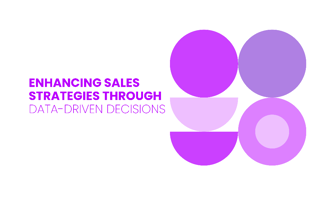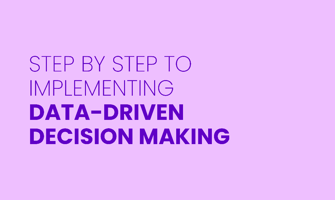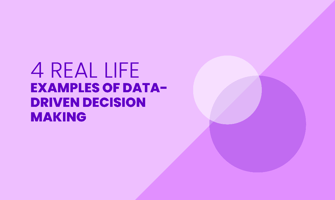Data is reshaping the way businesses operate, turning traditional approaches on their head and...
The Future of Data-Driven Decision Making and Predictive Analytics
Data-driven decision making (DDDM) and predictive analytics are reshaping how businesses strategize and operate.
Over the years, these technologies have evolved from simple data collection to sophisticated analysis tools that inform critical business decisions. Today, they stand at the forefront of business intelligence, integrating vast amounts of data with advanced analytical techniques to predict future trends and behaviors.
This article aims to explore the transformative impact of predictive analytics on businesses and examine emerging trends in data-driven decision making. We will uncover how these advancements not only enhance operational efficiency but also drive strategic innovation across various industries.
Advancements in Machine Learning and Artificial Intelligence (AI) Algorithms
Machine learning and artificial intelligence are set to become even more sophisticated. We can expect significant improvements in the accuracy, speed, and adaptability of these technologies. As machine learning evolves, it will likely include better classification models that can process complex datasets with greater efficiency.
Deep learning techniques will also see advancements. These enhancements mean that AI could be integrated more seamlessly with other emerging technologies, providing a broader range of applications across different sectors.
What the Future Means for Business
For businesses, the future looks promising thanks to these technological advancements. Enhanced machine learning algorithms will enable companies to make more precise decisions faster than ever before. This capability is crucial for developing scalable solutions that can grow with your business needs.
Moreover, integrating advanced artificial intelligence into business operations allows for increased personalization and automation opportunities. Whether it's through improving customer interactions or optimizing internal processes using big data insights from diverse sources like social media feeds or IoT devices—businesses stand to gain significantly from embracing these cutting-edge tools.
These developments not only streamline operations but also open up new avenues for innovation within various industries.
Expansion of IoT and Edge Computing
![]()
The number of Internet of Things (IoT) devices is set to grow significantly. This expansion will drive advancements in edge computing technologies, where data processing happens closer to the source rather than in a centralized system. The shift towards edge computing allows for faster response times and reduced latency, which is crucial as IoT devices become more prevalent across industries.
With this growth, we'll see an increase in the integration capabilities between different types of technology platforms. This means that your smart thermostat could communicate more efficiently with other smart devices in your home or workplace, creating a more interconnected environment. As these technologies develop further, they promise enhanced performance and greater utility from each device.
What the Future Means for Business
For businesses, the implications are vast. Enhanced IoT capabilities coupled with advanced edge computing can transform how companies collect and analyze data. Businesses will be able to process information on-the-go without significant delays—imagine analyzing customer behavior or operational efficiency in real-time during events or peak business hours!
This ability leads to unprecedented levels of operational responsiveness. For instance, retailers can use real-time data from IoT sensors to adjust inventory levels instantly based on foot traffic within stores or changes in weather patterns affecting shopping behaviors.
Furthermore, integrating diverse data sources becomes smoother with improved edge computing solutions; thus enabling businesses not only to enhance internal processes but also refine how they interact with customers through personalized experiences based on immediate data insights.
Improved Integration of Real-Time Data
Technological advancements are paving the way for more seamless integration of real-time data into business analytics frameworks. This shift is crucial as it allows companies to react swiftly and make informed decisions based on immediate data inputs. The key here lies in the development of systems that can not only gather but also analyze data instantaneously, thus supporting dynamic predictive models.
The importance of real-time data cannot be overstated, especially in environments where conditions change rapidly. For instance, financial markets or online retail platforms benefit immensely from being able to adjust strategies at a moment's notice based on the latest information. These sectors rely heavily on having up-to-the-minute data to stay competitive and responsive.
What the Future Means for Business
Real-time data analytics represent a significant leap forward in how businesses operate daily. By integrating these systems, companies gain faster response times which enhance situational awareness across all levels of operation. Industries such as manufacturing could see dramatic improvements; imagine sensors immediately reporting issues on an assembly line allowing for quick fixes without substantial downtime.
Moreover, industries like logistics stand to benefit by implementing real-time tracking systems that allow for adjustments in supply chain operations instantly based on weather changes or delivery updates. Customer service can also improve drastically with access to current customer feedback; this enables businesses to address concerns promptly thereby enhancing overall customer experience.
These enhancements contribute significantly towards operational efficiencies and strategic planning within any business landscape eager to maintain relevance and efficiency in today’s fast-moving markets.
Increased Automation in Decision Making
Automation is rapidly becoming a cornerstone in how businesses operate, thanks to advanced AI algorithms. These systems are not just programmed to perform repetitive tasks but are increasingly capable of making complex decisions based on large datasets. This shift is largely driven by the evolution of decision intelligence and predictive analysis techniques that allow for more nuanced interpretations of data.
AI's role in decision-making processes is expanding as it can analyze vast amounts of information much faster than human teams. With improvements in machine learning models, these automated systems can now identify patterns and make informed predictions with greater accuracy. The integration of AI helps streamline operations by reducing the time needed for data processing and analysis, thus speeding up decision-making cycles.
What the Future Means for Business
For businesses, automation means a significant transformation in their operational models. By reducing manual intervention, companies can focus on strategic planning and innovation while leaving routine decisions to intelligent algorithms. This shift not only enhances customer insights through detailed data analysis but also aids in risk mitigation by providing more accurate forecasts.
The impact on operational costs cannot be overstated; automation leads to reduced labor costs and improved efficiency which potentially boosts profitability across industries. As we move forward, embracing automated decision-making tools will be crucial for businesses aiming to maintain competitive edges and adapt swiftly to market changes.
Ethical and Privacy Considerations
As businesses increasingly leverage data-driven technologies, ethical challenges and privacy concerns are becoming more prominent. The use of vast amounts of personal data can lead to significant privacy implications if not managed properly. Transparency in how data is collected, used, and shared is crucial for maintaining user trust.
Future strategies will likely focus on developing robust frameworks that ensure ethical practices are embedded in all stages of data handling. This includes clear consent mechanisms, secure data storage solutions, and stringent access controls to safeguard sensitive information from unauthorized access or breaches.
What the Future Means for Business
Navigating this landscape requires a proactive approach to compliance with evolving privacy laws. Businesses must stay informed about regulatory changes to avoid penalties and reputational damage. Implementing comprehensive privacy policies that go beyond legal requirements can be a strategic advantage, fostering stronger relationships with customers by demonstrating respect for their personal information.
Moreover, as public awareness around data security grows, companies that prioritize ethical considerations in their operations are more likely to attract conscientious consumers who value transparency and integrity.
Finding the Balance Between Human and AI in Data-Driven Decision Making
The integration of artificial intelligence (AI) into decision-making processes is not about replacing human judgment but enhancing it. As we continue to develop sophisticated AI tools, the focus remains on augmentation rather than replacement. This approach ensures that AI systems support human decision-makers by providing comprehensive data analysis and predictive insights while preserving essential human oversight.
Human-AI collaboration has become a critical component in many sectors, effectively combining machine speed with human intuition. For instance, in healthcare, AI algorithms can analyze vast datasets to suggest diagnoses and treatment plans which doctors review and consider within their broader clinical knowledge and experience. This partnership allows for more informed decisions that benefit from both technological precision and personal expertise.
What the Future Means for Business
In business contexts, embracing a balanced approach between AI-driven analytics and human insight is crucial for strategic success. Companies are discovering that when machines handle data processing tasks, humans can focus on areas requiring creative thinking or ethical considerations—elements not easily replicated by algorithms.
Examples of successful human-AI collaborations include financial services where risk assessment models developed through machine learning are reviewed by analysts to ensure they align with current economic contexts before making investment decisions. Such practices enhance overall effectiveness by merging analytical rigor with contextual understanding.
This balanced strategy supports businesses in maintaining agility while ensuring decisions are both data-informed and contextually relevant—a combination likely to lead to superior outcomes across various industries.
Shift in Workforce Skills
As businesses increasingly adopt data-driven strategies, the demand for new skills and roles is inevitable. This shift means that not only will technical roles like data scientists need to be filled, but non-technical staff will also require a higher level of data literacy. The integration of big data into daily operations makes it essential for everyone within an organization to understand how to interpret and use this information effectively.
Education and training programs are crucial in preparing both current employees and future workforce members for these changes. These initiatives must focus on enhancing analytical skills across all departments, ensuring that every team member can contribute to a culture driven by informed decision-making.
What the Future Means for Business
For businesses, adapting to these shifts presents both challenges and opportunities. One major challenge is the need for continuous learning environments where employees can regularly update their skills in line with evolving technologies. However, this also offers an opportunity to enhance overall operational efficiencies as more team members become proficient in utilizing complex datasets.
Implementing robust workforce development programs is key not just for keeping pace with technological advancements but also for fostering innovation within teams. By encouraging skill adaptation among their staff, companies can ensure they remain competitive in a rapidly changing business landscape while improving strategic planning processes through enhanced internal capabilities.
Changing Regulatory Frameworks and Data Governance
As technology advances, so too must the frameworks that govern its use. We are likely to see significant changes in global data governance policies and regulatory landscapes. These shifts will be driven by the need to manage new complexities introduced by modern data usage. As we move forward, regulations might evolve to address these challenges, ensuring that data handling remains secure and ethical.
The future may bring more stringent requirements for transparency and user consent, especially as personal data becomes increasingly valuable in business operations. This could lead companies to invest heavily in securing their systems against breaches while proving compliance with international standards.
What the Future Means for Business
For businesses, adapting quickly to these changing regulations is crucial. Engaging proactively with upcoming regulatory developments can provide strategic advantages such as gaining trust from customers who value privacy highly. On the other hand, non-compliance could pose serious risks including financial penalties or damage to reputation.
To stay ahead of potential challenges, companies might consider forming dedicated teams focused on understanding impacts of legislative changes on their operations. This proactive engagement helps ensure that businesses not only comply with current laws but are also prepared for future amendments.
Advancements in Natural Language Processing (NLP)
![]()
The field of natural language processing (NLP) is set to experience significant improvements. These advancements will primarily enhance how machines understand human language. As NLP evolves, it will become more adept at interpreting the nuances and context of spoken and written communication. This progress is not just about understanding words but grasping the intent behind them.
Integration with other AI technologies will play a crucial role in this development. By combining NLP with sophisticated machine learning models, the accuracy of insights derived from textual data will improve dramatically. This synergy allows for a deeper analysis of text, making it possible to extract meaningful information more efficiently.
What the Future Means for Business
For businesses, these improvements in NLP mean substantial changes in customer service and user interaction interfaces.
Chatbots and virtual assistants are poised to become much more intuitive, capable of handling complex customer inquiries without human intervention. The ability to understand and respond accurately to customer needs based on their queries can significantly enhance user experience.
Moreover, NLP's potential extends beyond direct interactions; it can unlock deeper insights from unstructured data sources such as customer reviews and social media comments. Businesses that leverage advanced NLP techniques can gain a competitive edge by understanding consumer sentiments better, allowing them to tailor services or products more effectively.
Conclusion
This article has highlighted the transformative potential of advancements in Data-Driven Decision Making (DDDM) and predictive analytics.
These technologies are not just trends; they are reshaping how businesses operate, offering new levels of efficiency and insight. From machine learning enhancements to the expansion of IoT and edge computing, each development offers a unique set of opportunities for business strategy refinement.
The integration of real-time data and increased automation in decision-making processes empowers businesses to act swiftly, reducing operational costs while boosting profitability. Ethical considerations and privacy remain at the forefront as companies navigate these changes responsibly.
Looking ahead, the role of data-driven technologies will only grow more significant. Businesses that adapt to these changes proactively will not only stay competitive but also lead in innovation. The future is promising for those who leverage these insights effectively—continuing to evolve with technological progressions that shape our world.
FAQ
What are the latest trends in data science that are shaping the future of predictive analytics?
Key trends include the increased use of machine learning and artificial intelligence to automate data analysis, the adoption of cloud computing for scalability, and the growing importance of big data technologies that enable real-time analytics. These advances allow for more accurate and faster predictions and decision-making.
How can business intelligence and decision intelligence enhance data-driven decision making?
Business intelligence (BI) and decision intelligence (DI) provide frameworks and tools that transform raw data into actionable insights. BI helps in analyzing historical data to inform current decisions, while DI focuses on applying these insights directly to operational decision processes, thus enhancing strategic planning and operational efficiency.
What benefits do organizations gain from integrating advanced data and analytics into their operations?
Organizations can experience numerous benefits, including improved decision-making accuracy, enhanced operational efficiency, increased customer satisfaction through personalized services, and the ability to identify and capitalize on new business opportunities. Data-driven strategies also help in risk management and optimizing resource allocation.
What are the primary challenges faced by industries adopting predictive analytics?
Major challenges include data privacy and security concerns, the high cost of implementing advanced analytics solutions, a shortage of skilled personnel, and the complexity of integrating new technologies with existing IT infrastructure. Additionally, there is often a resistance to change within organizations that can hinder the adoption of new technologies.
How does data portability and interoperability contribute to the effectiveness of data-driven strategies?
Data portability allows for easier transfer of data across different platforms and systems, enhancing flexibility and reducing vendor lock-in. Interoperability ensures that disparate systems can communicate and work together efficiently, which is crucial for aggregating and analyzing data from multiple sources. Together, they enhance the effectiveness of data-driven strategies by ensuring that data is more accessible and actionable across the organization.




